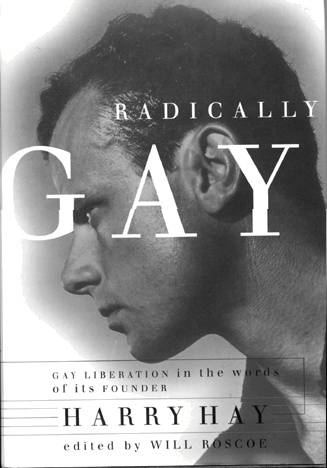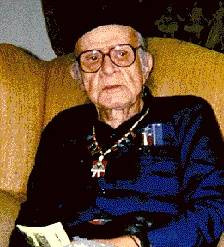Mattachine: Radical Roots of the Gay Movement: Difference between revisions
No edit summary |
(fixing video with new iframe format) |
||
| Line 42: | Line 42: | ||
[[Finocchio's | Pickups at Finocchio's c. 1930]] | [[Finocchio's | Pickups at Finocchio's c. 1930]] | ||
<iframe src="http://archive.org/embed/ssfHAYBVDCT" width="640" height="480" frameborder="0"></iframe> | |||
'''Harry Hay describes gay sex before zippers, c. 1930''' | '''Harry Hay describes gay sex before zippers, c. 1930''' | ||
Revision as of 21:11, 12 July 2012
Historical Essay
by Will Roscoe
Harry Hay in the 1930s
You can't hardly separate homosexuals from subversives ... A man of low morality is a menace to the government, whatever he is, and they are all tied up together. --Senator Wherry in N.Y. Post, 1950
It may come as a surprise that the gay movement not only began in the 1950s, but that its founders were former communists and radicals. Harry Hay, who wrote the first call for a gay movement in 1948, had been a party member for 20 years, active in labor organizing and cultural work. The fact that these organizers had already spent most of their lives outside the mainstream no doubt prepared them for the risks involved in forming a gay organization.
The modern gay movement in America began in Los Angeles, a city that symbolized the mobile, affluent lifestyle of Americans after the War. The Mattachine Foundation (to be distinguished from the post-1953 Mattachine Society) was formed in the winter of 1950 by a group of seven gay men gathered together by Hay. The name refers to the medieval Mattachines, troupes of men who traveled from village to village, taking up the cause of social justice in their ballads and dramas. By sharing and analyzing their personal experience as gay men, the Mattachine founders radically redefined the meaning of being gay and devised a comprehensive program for cultural and political liberation.
In 1951, Mattachine began sponsoring discussion groups. Years before women's "consciousness-raising groups," Mattachine provided lesbians and gay men a similar opportunity to share openly, for the first time, their feelings and experiences.
The meetings were emotional and cathartic. From 1950 to 1953 attendance snowballed. Soon discussion groups were meeting throughout California. As Dorr Legg described it, "The thing was growing. Never was there a mass movement in America like it. There were tens of thousands of people in the L.A. area involved with it.... You could go to a Mattachine meeting every night of every week, year in and out." Groups began to sponsor social events, fundraisers, newsletters, and publications.
In April 1951, Mattachine adopted a Statement of Missions and Purposes. This encompassing vision of gay liberation stands out in the history of the movement because it incorporated two important themes. First, Mattachine called for a grassroots movement of gay people to challenge anti-gay discrimination. At the same time, the organization recognized the importance of building community: "Mattachine holds it possible and desirable that a highly ethical homosexual culture emerge, as a consequence of its work, paralleling the emerging cultures of our fellow-minorities . . . the Negro, Mexican, and Jewish peoples."
This ideal of a gay cultural and political community with a unique place in democratic society linked Mattachine to Whitman's vision of a hundred years earlier.
The discussion groups proved effective in building gay consciousness. In 1952, the Mattachine founders pushed forward into political action. That spring, when one of the original members of the group was entrapped by the Los Angeles vice squad, Mattachine decided to mobilize the community and challenge the case in court.
Under the auspices of the Citizen's Committee to Outlaw Entrapment, Mattachine hired a lawyer, raised funds, published newsletters, and distributed leaflets. When the jury was unable to reach a verdict " and the case was dismissed " Mattachine claimed victory. An acknowledged homosexual had beaten the vice squad and been acquitted in court!
Encouraged by this success, Mattachine took an even bolder step the following year. In 1953, the group sent questionnaires to local political candidates, asking them to state their positions on gay rights issues.
In March, a local newspaper columnist wrote an article about this "strange new pressure group," noting that Mattachine's lawyer had been "unfriendly" when he appeared before the House Un-American Activities Committee. Of course, at this time McCarthy's anti-communist witch hunt was at its peak.
The article set off a panic among Mattachine members, who were horrified at the thought of their activities being linked to communism. In the controversy that followed, two conventions were held and opposing sides took shape. These conventions were unprecedented public meetings of gay people, attended by delegates representing hundreds of discussion group participants.
Conservative delegates questioned the organization's stated goals, challenging the idea that gay people were a minority. They claimed such an approach would only encourage hostility. Mattachine board members, however, argued that "we must disenthrall ourselves of the idea that we differ only in our sexual directions and that all we want or need in life is to be free to seek the expression of our sexual desires."
While efforts to adopt anti-communist resolutions failed at the conventions, the original leadership was shaken. They, too, feared the consequences of a government investigation of Mattachine activities, which would expose the identity of members and destroy the movement. So, in May 1953, the founders resigned, turning the movement over to the conservatives.
Unfortunately, the new leadership shared none of the vision or experience of the original founders. They drastically revised the goals of the organization, backtracking in every area. Instead of social change, they advocated accommodation. Instead of mobilizing gay people, they sought the support of professionals, who they believed held the key to reform. They stated, "We do not advocate a homosexual culture or community, and we believe none exists."
The results were devastating. Discussion group attendance fell and groups folded. The small core of members that remained, in San Francisco and other cities, invited psychiatrists to speak to them and sat patiently through the homophobic diatribes of these "experts," to prove their "impartiality." As Barbara Gittings said, "At first we were so grateful just to have people--anybody--pay attention to us that we listened to everything they said, no matter how bad it was.... It was essential for us to go through this before we could arrive at what we now consider our much more sensible attitudes."
Pickups at Finocchio's c. 1930
<iframe src="http://archive.org/embed/ssfHAYBVDCT" width="640" height="480" frameborder="0"></iframe>
Harry Hay describes gay sex before zippers, c. 1930
Video: Chris Carlsson, 1996
Harry Hay in 1996
photo by Chris Carlsson


